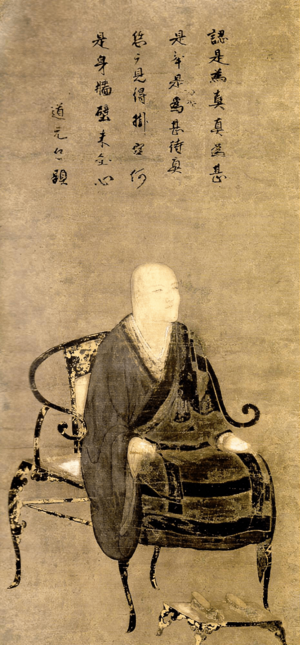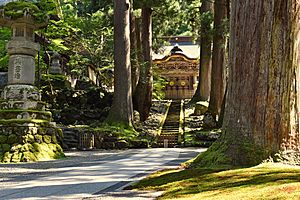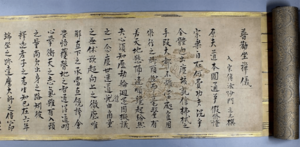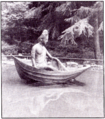Dōgen facts for kids
Quick facts for kids Dōgen |
|
|---|---|
 |
|
| Religion | Buddhism |
| School | Sōtō |
| Personal | |
| Born | 26 January 1200 Kyoto, Japan |
| Died | 22 September 1253 (aged 53) Kyoto, Japan |
| Senior posting | |
| Title | Zen Master |
| Predecessor | Rujing |
Dōgen Zenji (born January 26, 1200 – died September 22, 1253) was a very important Japanese Buddhist priest, writer, and thinker. He is famous for starting the Sōtō school of Zen Buddhism in Japan.
Dōgen first became a monk in the Tendai School in Kyoto. But he felt that their teachings were not complete. So, he traveled to China to find a deeper understanding of Buddhism. He stayed in China for four years. There, he learned from a great teacher named Tiantong Rujing, who was part of the Caodong lineage of Chinese Chan.
When Dōgen returned to Japan, he began teaching about zazen, which is sitting meditation. He wrote books like Fukanzazengi and Bendōwa to explain this practice. He eventually left the powerful Tendai School. After some time, he moved away from Kyoto to the mountains. There, he founded a monastery called Eihei-ji. This temple is still a very important center for the Sōtō school today.
Dōgen wrote many important works. His most famous book is the Shōbōgenzō (Treasury of the True Dharma Eye). He also wrote the Eihei Kōroku, which is a collection of his talks. Dōgen also wrote Japanese poetry and the Eihei Shingi, which was the first Zen monastic guide written in Japan.
Contents
Dōgen Zenji
His Early Life
Dōgen was likely born into a noble family in Japan. His mother is said to have passed away when he was seven years old.
Becoming a Monk
Later, Dōgen became a monk on Mount Hiei. This was the main place for the Tendai school of Buddhism. He had a big question about "original enlightenment." This idea said that all people are already enlightened. So, Dōgen wondered why practice was still needed.
He did not find an answer at Mount Hiei. He also did not like the politics there. So, Dōgen left to find other Buddhist teachers. He visited Kōin, an abbot at Onjō-ji Temple. Kōin suggested that Dōgen might find his answer by studying Chán in China. In 1217, Dōgen went to Kennin-ji Temple. He studied there under Myōzen, who was the student of another Zen Buddhist named Myōan Eisai.
His Journey to China
In 1223, Dōgen and Myōzen made a difficult trip across the East China Sea to China. They went to study at Jing-de-si monastery. This was the same place where Eisai had studied before. At this time, the Mongol Empire was fighting wars across China.
In China, Dōgen first visited many Chan monasteries. Most teachers there focused on using kōans (riddles or stories). Dōgen studied kōans, but he felt they were too heavily emphasized. He wondered why the Buddhist scriptures were not studied more.
Then, in 1225, he decided to visit a master named Rújìng (Japanese: Nyōjo). Rujing was a leader in the Cáodòng (Japanese: Sōtō) line of Zen Buddhism. He taught at Tiāntóng temple in Níngbō. Rujing was known for a different style of Chan teaching. Dōgen later called Rujing "the Old Buddha."
Under Rujing, Dōgen had a breakthrough. He felt a great sense of freedom when he heard Rujing say, "cast off body and mind." Myōzen, Dōgen's first teacher, died shortly after Dōgen arrived. In 1227, Dōgen received special approval from Rujing. He felt he had finally found the answer to his "life's quest."
Returning to Japan
Dōgen returned to Japan in 1227 or 1228. He went back to Kennin-ji temple. One of the first things he did was write Fukanzazengi. This short book gave instructions for zazen (sitting meditation). It explained how important zazen was.
However, problems soon started with the Tendai community. They tried to stop the new forms of Buddhism, like Zen. Because of this, Dōgen left Kyoto in 1230. He settled in an old temple in Uji, south of Kyoto.
In 1233, Dōgen started a small practice center called Kannon-dōri-in. He later made this temple bigger and named it Kōshōhōrin-ji.
Founding Eihei-ji
In 1243, a powerful person named Hatano Yoshishige offered to move Dōgen's community. They moved to Echizen province, far north of Kyoto. Dōgen agreed because of the problems with the Tendai community. Also, there was growing competition from the Rinzai-school of Zen.
His followers built a large practice center there. They first called it Daibutsu Temple. While it was being built, Dōgen lived and taught at Yoshimine-dera Temple. In 1246, Dōgen renamed Daibutsu-ji to Eihei-ji. This temple is still one of the two main temples of Sōtō Zen in Japan today. The other is Sōji-ji.
Dōgen spent the rest of his life teaching and writing at Eihei-ji. In 1247, the new leader of Japan, Hōjō Tokiyori, invited Dōgen to Kamakura. Dōgen made the long trip to teach him. He then returned to Eihei-ji in 1248. In 1252, Dōgen became very ill. He gave his robes to his main student, Koun Ejō. Ejō then became the abbot of Eihei-ji.
His Death
Dōgen left for Kyoto in 1253 to find a cure for his illness. But he passed away soon after arriving in Kyoto. Before he died, he wrote a death poem:
Fifty-four years lighting up the sky.
A quivering leap smashes a billion worlds.
Hah!
Entire body looks for nothing.
Living, I plunge into Yellow Springs.
Stories About Dōgen
Many stories tell of special events in Dōgen's life. These stories helped show his great spiritual power. They also helped confirm that his teachings were true.
One famous story happened when he was sailing back to Japan from China. A big storm hit the ship. The crew feared the ship would sink. Dōgen then led everyone in chanting to Kannon (Avalokiteshwara), a Buddhist figure. Kannon appeared to him, and some of the crew saw her too. After this vision, the storm calmed down. Everyone believed they were saved because of Kannon. There is even a statue of this event at Eihei-ji Temple today.
Dōgen's Teachings
Zazen: Sitting Meditation
Dōgen always said that zazen, or sitting meditation, was the most important Buddhist practice. He believed that studying Zen was the same as doing zazen. He taught zazen to everyone, no matter their social class or gender.
When Dōgen talked about zazen, he often meant shikantaza. This means "just sitting." It is a type of meditation where you sit with a clear, alert mind. You don't focus on any object, and you don't get caught up in thoughts. Dōgen called this "without thinking." It means being aware of things as they are, beyond thinking or not thinking.
For Dōgen, the right way to do zazen was without trying too hard. This is because he believed that enlightenment is already always there.
Practice and Enlightenment
A main idea in Dōgen's Zen teaching is "the oneness of practice-verification." This means that practicing Buddhism and reaching enlightenment are not separate things. They are one and the same. This teaching was first explained in his book Bendōwa.
Buddha-Nature
For Dōgen, buddha-nature means all of reality. He wrote that "whole-being is the Buddha-nature." This means even things like rocks, sand, and water show buddha-nature. He did not believe that buddha-nature was a fixed, inner self. Instead, Dōgen described it as "vast emptiness" and "the world of becoming." He wrote that "impermanence is in itself Buddha-nature." This means that everything changing and passing away is part of buddha-nature.
So, for Dōgen, buddha-nature includes everything. This includes all living things and even objects like grass and trees.
Time-Being
Dōgen's idea of Being-Time, or Time-Being (Uji), is a key part of his philosophy. It means that time itself is being, and all being is time. All changing activities and all things in the world are time. These two ideas are linked to show that they are not separate.
Dōgen's Writings
Dōgen often wrote in Japanese, even though it was common for Buddhist works to be in Chinese. He wrote in a clear, strong, and inspiring way. Dōgen was a master writer, known for his prose and his poetry. He used language in new and interesting ways. He tried to express things that were hard to put into words.
Shōbōgenzō
Dōgen's most important work is the Shōbōgenzō (Treasury of the True Dharma Eye). This is a collection of his talks and writings in ninety-five parts. It covers many topics. These include zazen, koans (Zen riddles), Buddhist philosophy, monastic rules, and the idea that women and men are equal. It also talks about language, being, and time.
Shushō-gi
The Shōbōgenzō was used to create a shorter book called Shushō-gi. This book was put together in 1890. It contains key parts from the Shōbōgenzō. It helps explain Dōgen's main teachings to people who are new to Zen.
Shinji Shōbōgenzō
Dōgen also put together a collection of 301 koans in Chinese. These did not have his own comments. This collection is called the Shinji Shōbōgenzō. Dōgen called these stories kosoku (ancestral rules) or innen (circumstances of a story). For Dōgen, the word kōan meant "absolute reality" or the "universal Dharma."
Collections of Talks
Lectures that Dōgen gave to his monks at Eihei-ji were collected in a book called Eihei Kōroku. This book has ten volumes. It includes his sermons, lectures, sayings, and poetry. His main students put it together after Dōgen passed away.
Another collection of his talks is the Shōbōgenzō Zuimonki. These are talks Dōgen gave to his student, Ejō. Ejō wrote down and edited these talks.
Other Writings
Some of Dōgen's other important writings include:
- Fukanzazengi (General Advice on the Principles of Zazen): Written soon after he returned from China in 1227.
- Bendōwa (On the Endeavor of the Way): Written in 1231. This book explains why shikantaza (just sitting) practice is so important.
- Eihei shoso gakudō-yōjinshū (Advice on Studying the Way): Likely written in 1234.
- Tenzo kyōkun (Instructions to the Chief Cook): Written in 1237.
- Bendōhō (Rules for the Practice of the Way): Written between 1244 and 1246.
- The earliest work by Dōgen is the Hōkojōki (Memoirs of the Hōkyō Period). This book is a collection of questions and answers between Dōgen and his Chinese teacher, Tiāntóng Rújìng. Ejō found this book among Dōgen's papers after his death.
His Legacy
Dōgen believed that the correct teachings of Buddhism should be passed down carefully. His main students included Koun Ejō, Giin, Gikai, and Gien.
A very important person who followed Dōgen was Keizan (1268–1325). He founded Sōji-ji Temple. Keizan also wrote the Record of the Transmission of Light (Denkōroku). This book traces the line of Zen masters from Siddhārtha Gautama up to Keizan's time.
Together, Dōgen and Keizan are seen as the founders of the Sōtō school of Zen in Japan.
See also
 In Spanish: Dōgen para niños
In Spanish: Dōgen para niños
- Zen - 2009 Japanese movie about Dōgen's life
Images for kids





